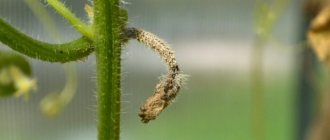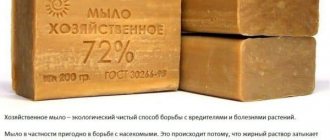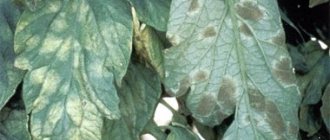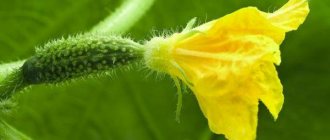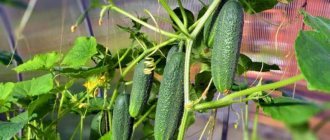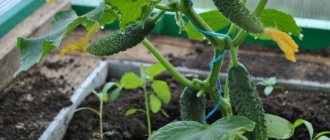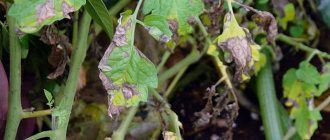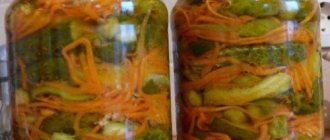The causative agent of infection
The appearance of the disease is provoked by fungi of the genus Peronospora - lower species from the Peronosporaceae family. Pseudofungi parasitize on plant leaves in summer; in winter they live in organic debris in the form of dormant oomycete spores. When the air warms up to + 10 – 13℃, zoospores are activated and begin to germinate. Microorganisms move quickly in a humid environment and create mycelium in the tissues of the cucumber.
We recommend reading: Diseases of cucumbers.
During the summer season, the infectious agent generates at least 15 generations of new mushrooms. The spores, which intensively capture healthy plants, remain in the soil for six years. Spread by precipitation and air currents. Transmitted through contaminated seeds and soil. The source of infection is increased by insect pests (aphids, whiteflies, ants).
Note! Moisture is necessary for the spread of peronosporosis pseudofungi. The pathogen does not affect dry organic tissues.
Photo
What is downy mildew on cucumbers?
This disease occurs as a result of spores of the fungal pathogen Peronospora entering the cucumber bush in conditions of high humidity. Zoospores are aggressive in nature and tend to rapidly multiply and spread, and penetrate into the living organism of the plant.
The mycelium is actively growing and soon the first signs of infection with a fungal disease begin to form in the form of white-gray, sometimes with a purple tint, spots with a slight fluff.
Did you know? More than 6 thousand years ago, people first began to eat cucumbers. Mentions of them can be found in Egyptian writings, confirming that this vegetable was placed in the tomb of the pharaoh.
In addition to the fact that fungal spores successfully reproduce on their own, the process of increasing their numbers is also facilitated by pests such as aphids and whiteflies.
Conditions for the occurrence of the disease
In dry, hot weather (from +27℃) the disease caused by pseudofungi does not develop. Infection occurs under unfavorable weather conditions: moderately warm weather during the day (+18 - 20℃) and lower temperatures at night; increased (80 – 100%) air humidity; prolonged precipitation, fog. Inappropriate conditions for growing cucumbers also lead to the intensive development of peronosporosis:
- thickening of plantings;
- water getting on the leaves of the plant;
- watering with cold water;
- waterlogging of the soil;
- contamination of beds with weeds.
In open ground, the disease is also caused by heavy dew, in a greenhouse - by poor ventilation. Peronosporosis is sometimes accompanied by bacterial infections - root rot, bacteriosis.
Farmer F1
The hybrid is resistant to cold weather and diseases of cucumber crops. Produces predominantly female flowers and is grown in greenhouses and garden beds. Mid-season, bee-pollinated, hardy variety. The shoots grow intensively throughout the growing period.
The fruits have a bright taste and aroma, without bitterness or emptiness. The peel is dark green, tuberous, with spikes. Zelentsy can be harvested until October due to the crop’s unpretentiousness to temperature changes.
- Author: Inna Kiseleva
Rate this article:
- 5
- 4
- 3
- 2
- 1
(1 vote, average: 5 out of 5)
Share with your friends!
Disease development cycle
In open ground, the first signs of peronosporosis begin to appear at the end of July - the first half of August. Cool rains often occur at this time, and there is a sharp contrast between day and night temperatures. In the greenhouse, the infection is diagnosed throughout the summer season. The disease develops quickly.
Through the moistened film on the plant, zoospores penetrate into the pores of the leaves. After this, the mycelium penetrates through the vessels of the leaf, enters the shoots, and affects the root system and seeds. The bush becomes completely infected with pseudofungi. The incubation period lasts three days. Then the infection begins to manifest itself openly:
- oily, angular spots of a yellow hue form on the upper part of the leaf;
- within two days the spots darken and look like burns;
- on the fifth day of abundant sporulation, the mycelium appears on the underside of the leaf as barely visible bluish-gray fleecy streaks;
- due to darkening and increasing spots, the leaves of the plant acquire a uniform brown color;
- the edges of the leaf thicken and curl;
- When they dry out, the leaves fall off.
Falling leaves affects the condition of the plant: it leads to delayed development of ovaries and slows down fruiting. The fruits become deformed, become pale green and tasteless.
Important! If downy mildew attacks cucumbers at the beginning of the season, this leads to a lack of flowering and the formation of ovaries. In this case, the infected plants cannot be saved. To avoid further spread of the disease, the bushes are dug up and destroyed.
Methods of protection
There are various ways to protect cucumbers from the appearance and spread of peronosporosis.
Basic recommendations
There are several basic recommendations that will help prevent downy mildew in cucumbers:
- You need to plant the seeds in places where it will be quite difficult to become infected with downy mildew. Planting should be done in areas with pre-treated soil.
- After harvesting the fruits, it is necessary to disinfect the soil and get rid of plant residues.
- During the growing season, it is necessary to monitor soil moisture.
- It is recommended to cultivate varieties with resistance to downy mildew. These include Zodiac, Debut, Idol, Fontana and Photon.
- When growing cucumbers in a greenhouse, you need to monitor the microclimate in it to avoid dripping moisture on the leaves.
- The soil must be regularly fertilized with organic and mineral substances, which increase the resistance of cucumbers to various diseases.
- If some bushes have already become infected with downy mildew, they should be destroyed immediately. This will prevent the disease from spreading to other plants.
Soil care
The area must be regularly cleared of fallen leaves in which zoospores can develop. Also, the ground must be periodically disinfected and dug to a depth of about 35-40 cm. If the bushes were infected in the previous year, then it is better to repeat the digging again in the spring.
See also
How to grow cucumbers in open ground in the Leningrad region, the best varietiesRead
Soil disinfection is carried out using a 1% solution of potassium permanganate and a 3% solution of copper sulfate. These mixtures must be used very carefully, as they can harm not only pathogenic, but also beneficial microflora.
In the garden, it is imperative to observe cultural rotation. The culture can be returned to its original place only after 4-5 years. If you plant cucumbers in the same place for several seasons, an accumulation of bacteria and infections may occur. This increases the likelihood of contracting peronosporosis.
Plant care
To make cucumbers more resistant to diseases, they need to be planted correctly. Before planting, you should disinfect the seeds. This can be done using heat treatment. To do this, the seeds are heated to 35-40°C for 15-20 minutes. You can treat cucumber seedlings with a weak 0.1% solution of potassium permanganate. In this case, its roots are immersed in the mixture for several hours.
During the growing season, it is necessary to monitor the spread of weeds. You also need to regularly get rid of plants that can no longer be cured of powdery mildew. They should be dug up first and then burned.
Differences between downy mildew and black spot
Noticing common symptoms of cucumber infections, gardeners sometimes confuse downy mildew with powdery mildew and black spot. This makes it difficult to choose a treatment option.
“True” and downy mildew
The commonality between the two varieties of powdery mildew - downy and “real” - is that both infections are caused by pseudofungi, the symptoms appear on the leaves. The difference is associated with the time of appearance of the white coating: with powdery mildew, the coating covers the leaves at the beginning of infection, and with peronospora - at the height of the epidemic.
Control measures
Having once settled on a site, peronosporosis sometimes lingers there for several years. Therefore, the gardener has 2 goals: to cure the infected plant and stop the life cycle of pseudofungi. Infected leaves are removed. The cut areas are lubricated with brilliant green or dusted with charcoal powder; replace the top layer of soil. After this, treatment begins.
Chemicals
Fungicidal preparations are recognized as effective chemical agents that destroy the causative agent of peronosporosis by 85–95%:
- Ordan: destroys the RNA of microorganisms and protects plant tissues from the penetration of pathogens. Use economically: dissolve 5 g of product in a liter of water. The resulting liquid is enough to treat at least 20 m2. Spray the bushes 3 times: when 5 leaves form, then after 1.5 weeks. The last treatment is no later than 10 days before harvesting the fruits.
- Abiga-Pik - suspension destroys parasites at the cellular level. Blocks the entry of the infectious agent into the cucumber tissue (the substance does not get inside the greens). Supports chlorophyll production. The sticky solution comes into close contact with leaves and shoots. The drug is compatible with other fungicides. Valid at temperatures from + 9℃.
- Previkur Energy: suppresses the development of phytopathogens; stimulates root formation and the development of healthy cells. Before sowing the seeds, water the soil: for 2 m2 a solution consisting of 4 liters of lukewarm water and 6 ml of product is required. It is also used for foliar feeding and watering of cucumbers (alternating procedures is possible). A working solution for treating 100 m2 is prepared by adding 15 ml of the substance to 20 liters of settled water.
- Kurzat: used for the first time to prevent infection when 2 true leaves are formed; subsequent ones - to treat the plant (after 1.5 weeks). The effect lasts 3 days after spraying the bushes.
- Consento - for treatment, strengthening the immune system and activating the growth of vegetable crops. The bushes are sprayed three times a season. Depending on the weather, the drug is effective for 10–15 days. Cucumbers are harvested 2.5 weeks after the last treatment.
Treatment of seedlings for peronosporosis
Seedlings infected with peronosporosis are fed with a solution of ammonium nitrate or urea (1 g per liter of water) 48 hours before planting in a permanent place. To prepare medicinal solutions, Bordeaux mixture and preparations containing copper are also used: HOM, Oxychom. Young bushes on which the first yellow spots have appeared are pollinated with sulfur powder at least three times. The substance destroys the infectious agent. To treat an area of 10 m2 once, you will need 30 g of sulfur.
Important! To prevent oospores from re-entering the soil, infected plant fragments are not placed in the compost mixture, since this is a favorable environment for the proliferation of microbes. Infected leaves are removed and burned. If the fungus has infected the bush by 50%, the plant is completely destroyed.
Folk remedies
The actions of folk remedies are productive at the onset of the disease or when used together with chemicals. Popular means of combating peronosporosis include:
- a mixture of skim milk and iodine - for preventive spraying and treatment in the initial stage of the disease (5 liters of settled water + 15 drops of iodine + 500 ml of milk);
- horsetail decoction - for watering (pour 500 g of herb with a liter of settled water overnight, boil in the morning; strain the cooled solution; add 5 parts of water to part of the decoction);
- wood ash - for dusting bushes with dry powder (50 g per 1 m2) or for watering and spraying (pour 1 liter of ash with a liter of boiling water; strain the cooled product and dilute with 5 liters of settled water);
- garlic broth - for foliar feeding (add 150 g of chopped garlic to 5 liters of water, boil; strain the infused broth);
- a mixture of soda and soap shavings - for spraying cucumbers (2 tablespoons of soda are dissolved in five liters of warm water, add 30 g of soap shavings).
Vegetable leaves are sprayed in the early morning or evening in dry weather to protect against possible sunburn and increase the exposure time of the product.
Video: “How to prepare a miracle solution that protects cucumbers from peronosporosis and other fungal infections (+ feeding)”:
Preparations for treatment: fungicides, serums and others
The biological effectiveness of chemicals is 87-89%. This is almost twice as effective as biological fungicides. Therefore, at the risk of losing the entire harvest, you need to opt for them. These drugs can be treated only 20 days before fruiting.
Chemical fungicides (aqueous solutions)
- "Ridomil Gold MC" (25 g / 10 l);
- "Ordan" (20 g/10 l);
- “Copper oxychloride” (40 g/10 l);
- "Oxychom" (20 g/10 l);
- "Efal" (20 g/10 l);
- "Previkur" (20 g/10 l).
Details about the consumption rates of each drug and protective measures during operation are indicated in the instructions.
Treatment is carried out twice with frequent intervals of 5-7 days. A larger number of treatments is undesirable. These drugs can dry out the leaves and slow down the growth of shoots, which is especially undesirable in cases of peronospora.
An important condition for effectiveness is complete coverage of the solution and dryness of the plants. For spraying, choose dry, windless weather, the hours when the morning dew disappears. The surface of the soil is also treated with the solution.
The preparations must remain on the plants for at least 2 hours. If it rains after treatment, spraying is repeated.
The strobilurin drugs “Quadris” and “Strobi” have lower effectiveness in the treatment of peronosporosis. Therefore, they are used for preventive spraying in the 3-4 phase of the true leaf, and treatment is carried out with the drugs described above.
The Bordeaux mixture of copper sulfate and lime, often recommended for the treatment of infection, is ineffective for peronospora.
Biological drugs
These remedies are used for minor damage or during fruiting of the cucumber. The drugs are also actively used to prevent infection.
Preparations (aqueous solutions):
- "Trichodermin" (30 g/10 l);
- "Trichofite" (30 g/10 l);
- "Gamair" (10 tablets/10 l);
- "Fitosporin M" (50 ml open ground, 30 ml in a greenhouse per 10 liters of water).
Work with working solutions in cloudy but dry weather. Spraying is carried out 2-3 times at the interval specified in the instructions. Preventive spraying is carried out with solutions of lesser concentration src=»https://rufazenda.ru/wp-content/uploads/2018/04/fitosporin_2-700×450.jpg» class=»aligncenter» width=»700″ height=»450″ [/img]
Folk remedies
Home remedies are not able to stop a severely progressed infection. They are used only for minor damage to plants or in combination with biological preparations.
Recipes:
- baking soda (30 g), liquid soap (10 ml) are dissolved in hot water (5 l), cool;
- iodine (10 drops) is dissolved in milk (1 l) and diluted in water (10 l);
- potassium permanganate (1-2 g) is dissolved in water (10 l);
- ash (300 g) is poured with boiling water (2 l), boiled for 30 minutes, left for 2-3 hours, diluted in 10 l of water and added 50 g of soap;
- horsetail (100 g) is poured with water (1 l), left for 1 day, boiled for 2 hours, filtered and diluted with water 1:5;
- Fermented milk whey is diluted with cold water 1:2.
Plants are sprayed 3-4 times with an interval of 5-7 days.
An experienced gardener talks about how to protect the cucumber crop from peronosporosis.
Prevention
To prevent cucumbers from becoming infected with peronosporosis, you should worry in advance and eliminate favorable conditions for the propagation of the infectious agent:
- do not allow plantings to thicken. The bushes are arranged in a checkerboard pattern: 4 specimens per 1 m2. The distance between plants in a row is 0.4 m; between rows – 0.5 m.
- Follow the rules of crop rotation, sow cucumbers after onions, beets, garlic, legumes and nightshade crops; Do not grow in the garden after pumpkin.
- Plant in the same area 2 years after the last planting.
- Water the vegetables under the roots with water that has been left in the sun, avoiding moisture getting on the leaves.
- Control insect pests that spread the causative agent of downy mildew. To do this, plant plants with a strong smell in the beds with cucumbers: marigolds, calendula, dill; Place wormwood branches on the ground.
- Preventively spray the bushes with chemicals and folk remedies to strengthen plant tissues.
- Do not get carried away with fertilizers containing large quantities of nitrogen: by acidifying the soil, the substance creates conditions for the development of infection.
- Regularly ventilate the greenhouse, maintain air humidity within 75 - 80%.
- For sowing, choose cucumber varieties that are resistant to the disease.
- Remove and burn infected plant fragments.
- In the fall, change the top layer of soil in the greenhouse. If this cannot be done, in the spring, before planting seedlings, the soil is disinfected with fungicides.
Preparing seeds and soil
Mandatory preventive measures to protect cucumbers from peronosporosis include pre-sowing treatment of seeds and soil. The seeds are kept for 20 minutes in hot water or in a one percent solution:
- potassium permanganate;
- boric acid;
- zinc sulfate;
- ammonium molybdate;
- magnesium sulfate.
The soil for sowing seeds is calcined in the oven at a temperature of 75℃ for 25 minutes. After cooling, water with fungicides (Topaz, Fitosporin, Alirin B, Fundazol).
Video: “Peronosporosis of cucumbers. Methods of struggle":
Additional information: After steaming or calcining in the oven, the soil is cooled and laid out on an oilcloth in an even layer. Leveling will help to slightly loosen and fill the soil with air.
How to recognize the disease
Downy mildew of cucumbers is a fungal disease.
Previously, this disease was found only in the Far East, but today it is widespread in other regions. An effective means of combating it has not yet been found. Fungal spores can easily be introduced into a greenhouse with seeds if they are not treated, with soil, or in other ways. If cucumbers affected by the disease are not treated, the disease can spread to neighboring plants and related crops (pumpkin, zucchini, melons). The fungus affects plants at any stage of development. Recognizing the disease is quite simple. Yellow and brown spots appear en masse on the leaves of cucumbers, and a brown and black coating appears on the reverse side. The spots quickly grow, filling the entire surface of the leaf. Fruits and other parts of the plant are not affected by the fungus. But as a result of the disease, the cucumber foliage dries out, which means that no food is supplied to the fruits, and they remain underdeveloped. If diseased plants are not treated, their fruiting quickly stops and they themselves die.
Damage to cucumber leaves
Varieties and hybrids resistant to downy mildew
Breeders have developed hybrids and varieties of cucumbers that are resistant to downy mildew, as well as other fungal infections.
The following options are popular:
- Nutcracker F1 is an early ripening hybrid of a parthenocarpic species, grown in open ground and in a greenhouse. Tall bushes with strong branching. Large-tuberous white-thorn cucumbers grow up to 13 cm.
- In my opinion, F1 is a variety form with a developed central stem and short lateral shoots. Up to 4 greens are formed in bunched ovaries. After harvesting the cucumbers, new fruits are set in this place. The skin is covered with sparse spines. As the fruit ripens, the white spines turn brown.
- Phoenix Plus is a bee-pollinated mid-season salad variety. Tall plants branch heavily. The length of the cucumbers is 15 cm. The yield is 7 kg/m2.
- Corporal F1 is an early ripening hybrid for open and closed types of soil. It stands out for its productivity. On medium-climbing plants, the fruits ripen simultaneously. Universal cucumbers.
- Malachite box F1 is a self-pollinating early-ripening hybrid. 4–5 dark green specimens are formed in a node. The coarsely tuberous “shirt” is covered with a waxy coating. Cucumbers can be preserved and used fresh.
- Dalnevostochny 27 is a bee-pollinated variety with strong branching of the central stem. Few leaves are produced, which makes caring for the plantings and harvesting easier. The surface of the dark green elliptical fruit is covered with tubercles. Sweet crispy cucumbers are stored for a long time.
- Thumb Boy is an early ripening, self-pollinating gherkin-type variety. Suitable for canning.
- Primadonna F1 is a parthenocarpic hybrid of early maturation. On a vigorously climbing tall plant, short cucumbers are tied in bunches. Brings harvest regularly.
- Mels F1 is a super-early, self-pollinated hybrid. Harvest look. Bright green, large-tubercular gherkins are formed in a bunch.
- Sheer perfection F1 is a bee-pollinated variety for growing in closed greenhouses and greenhouses. The bushes are compact. Productivity – at least 30 kg per m2. Cucumbers ripen quickly and evenly.
Popular hybrids and varieties of cucumbers are distinguished by their early fruiting. If you correctly determine the timing of sowing, the plants will have time to produce a harvest before the onset of unfavorable weather conditions. Seed producers guarantee the resistance of these species to downy mildew. But even if the fungus infects cucumbers, the disease will be mild and will reduce the yield slightly.
Fungal infections often affect vegetable crops. Phytopathogens are aggressive and act quickly. Protecting cucumbers from peronosporosis requires the gardener to be attentive and knowledgeable about chemical and folk remedies. To keep the plant healthy, it is important to see the first signs of disease in time and prevent the development of infection.
What is the difference between disease resistance and tolerance
In relation to any disease, all varieties and hybrids of cultivated plants can be divided into:
- Susceptible . Plants that, even with a slight infectious background, show all the signs of the disease.
- Highly resistant . Plants capable of inhibiting the growth and development of pathogens under average infectious background. Under unfavorable conditions, when there are too many pathogens, some symptoms may still appear.
- Moderately resistant . These varieties “lose” to highly resistant ones, but, on the other hand, show much less disease symptoms than susceptible crops under the same conditions.
In contrast to resistance, tolerance of a variety to a particular disease means that the plant is not able to resist the pathogen and may become ill. But at the same time it will retain the ability to bear fruit and be able to produce a harvest.
In addition, there is such a thing as “immune” or “genetically resistant varieties.” Such plants are generally not capable of getting sick, even if they are purposefully infected with a certain pathogen. True, we have not yet encountered immune varieties and hybrids among cucumbers.
